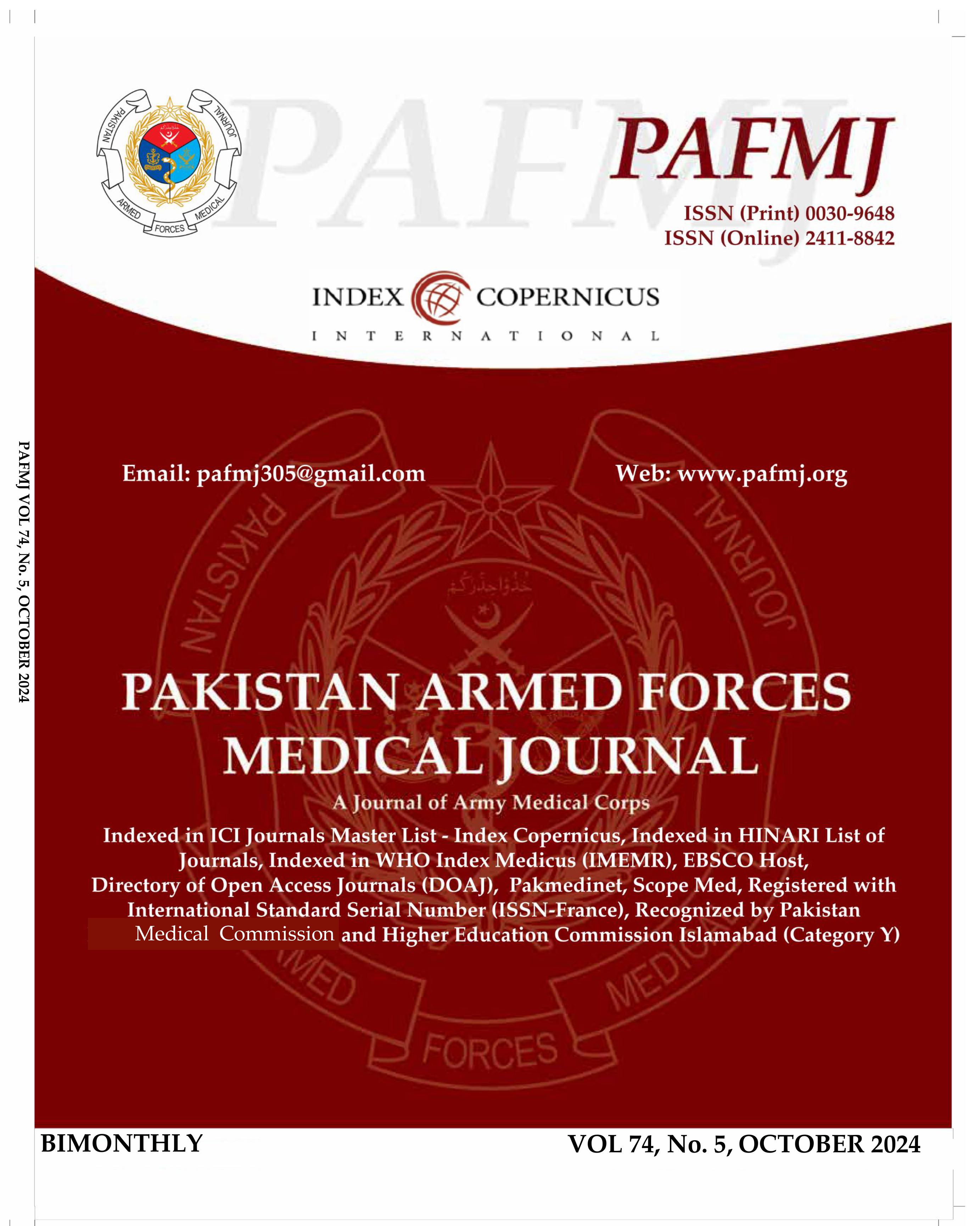Comparison of Self-Esteem in Patients Before and after Chemical Skin Peeling: An Interventional Study
DOI:
https://doi.org/10.51253/pafmj.v74i5.10377Keywords:
: Chemical peeling, Chemexfoliation, RSES (Rosenberg Self-Esteem Score), Self-esteem, Salicylic acid, Skin Peeling Agents.Abstract
Objective: To evaluate the self-esteem of patients undergoing chemical peeling for therapeutic reasons.
Study Design: Pre-post Observational study.
Place and Duration of Study: Department of Dermatology Combined Military Hospital, Multan Pakistan, from Mar to Aug 2021.
Methodology: Forty-four patients were included in the study. After detailed history and clinical examination, self-esteem of all selected patients meeting the inclusion criteria was determined using RSES (Rosenberg Self-Esteem Score) score. Four sessions of chemical peeling were done using 30% salicylic acid with interval of 2 weeks between each session. (At week 0, 2, 4 and 6) All patients were advised the use of similar sun blocks during the treatment period. Post-peel RSES was re-assessed at 6 weeks.
Results: The pre-peel RSES score (17.95±2.29) improved significantly after the sessions of chemical peeling. The post-peel RSES score was (19.47±1.95). p-value<0.001
Conclusion: Our study showed chemical peeling with 30% salicylic acid caused a significant enhancement of patients’ self- esteem, as significant difference in Rosenberg Self-Esteem Scores was seen before and after chemoexfoliation.
Downloads
References
Branden N. The power of self-esteem. Health Communications, Inc.; 2021.
Abdel-Khalek AM. In book: Self-esteem: perspectives, influences, and improvement strategies. Edition: 1st Nova Science Publisher; 2016.
Zhang XJ, Wang AP, Shi TY, Zhang J, Xu H, Wang DQ, et al. The psychosocial adaptation of patients with skin disease: a scoping review. BMC Public Health 2019; 19(1): 1404.
https://doi.org/10.1186/s12889-019-
Costeris C, Petridou M, Ioannou Y. Psychological Impact of Skin Disorders on Patients’ Self-esteem and Perceived Social Support. J Dermatol Skin Sci 2021; 3(1): 14-22 .
Ribeiro RM, Bragiola JVB, Eid LP, Pompeo DA. Impact of self-esteem and of the sociodemographic factors on the self-efficacy of undergraduate nursing students. Texto Contexto-Enfermagem 2019; 29: e20180429.
https://doi.org/10.1590/1980-265X-TCE-2018-0429
Bundy C, Cordingley L. Psychological and social impact of longterm dermatological conditions. 9th edition. Rook‘s textbook of dermatology; 2016.
Borelli C, Ursin F, Steger F. The rise of Chemical Peeling in 19th-century European Dermatology: emergence of agents, formulations and treatments. J Eur Acad Dermatol Venereol 2020; 34(9): 1890-1899.
https://doi.org/10.1111/jdv.16307
Lee KC, Wambier CG, Soon SL, Sterling JB, Landau M, Rullan P, et al. Basic chemical peeling—superficial and medium-depth peels. J Am Acad Dermatol 2019; 81(2): 313-324.
https://doi.org/10.1016/j.jaad.2018.10.079
Monheit G, Tayebi B. Chemical peels and dermabrasion. Fitzpatrick‘s dermatology. 9th ed;2019:p.3895-3905.
Baker A. An overview of chemical peel formulations. PMFA J 2020; 8(1).
Kouris A, Platsidaki E, Christodoulou C, Efstathiou V, Markantoni V, Armyra K, et al. Patients' self-esteem before and after chemical peeling procedure. J Cosmet Laser Ther 2018; 20(4): 220-222. https://doi.org/10.1080/14764172.2017.1400168
Gallitano SM, Berson DS. How Acne Bumps Cause the Blues: The Influence of Acne Vulgaris on Self-Esteem. Int J Womens Dermatol 2017; 4(1): 12-17.
https://doi.org/10.1016/j.ijwd.2017.10.004
Connelly R, Gayle V, Lambert PS. A Review of occupation-based social classifications for social survey research. Methodol Innov 2016; 9:1-14. https://doi.org/10.1177/2059799116638003
Soleymani T, Lanoue J, Rahman Z. A Practical Approach to Chemical Peels: A Review of Fundamentals and Step-by-step Algorithmic Protocol for Treatment. J Clin Aesthet Dermatol 2018; 11(8): 21-28.
Sobanko JF, Dai J, Gelfand JM, Sarwer DB, Percec I. Prospective Cohort Study Investigating Changes in Body Image, Quality of Life, and Self-Esteem Following Minimally Invasive Cosmetic Procedures. Dermatol Surg 2018; 44(8): 1121-1128.
https://doi.org/10.1097/DSS.0000000000001523
Tayel K, Attia M, Agamia N, Fadl N. Acne vulgaris: prevalence, severity, and impact on quality of life and self-esteem among Egyptian adolescents. J Egypt Public Health Assoc 2020; 95(1): 30. https://doi.org/10.1186/s42506-020-00056-9
Kaikati J, Zoghaib S, Kechichian E, Stephan F, Helou J, Sleilaty G, et al. The impact of acne treatment on quality of life and self-esteem: A prospective cohort study from Lebanon. Int J Womens Dermatol 2021; 7(4): 415-421.
https://doi.org/10.1016/j.ijwd.2021.03.005
Dabas G, Vinay K, Parsad D, Kumar A, Kumaran MS. Psychological disturbances in patients with pigmentary disorders: a cross-sectional study. J Eur Acad Dermatol Venereol 2020; 34(2): 392-399. https://doi.org/10.1111/jdv.15987
Downloads
Published
Issue
Section
License
Copyright (c) 2024 Maria Rasheed, Sumeera Zulfiqar, Ahsan Bari, Alina Zainab

This work is licensed under a Creative Commons Attribution-NonCommercial 4.0 International License.















